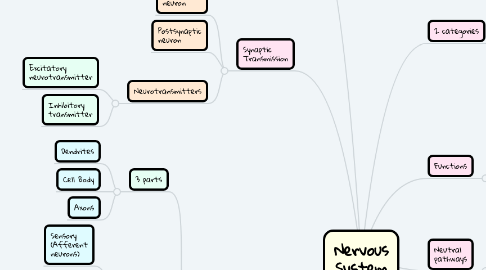
1. 2 categories
1.1. Central Nervous system
1.1.1. Brain
1.1.2. Spinal Cord
1.2. Peripheral Nervous System
1.2.1. Autonomic Nervous System
1.2.2. Somatic Nervous System
1.2.3. Enteric Nervous System
2. Action potential
2.1. Conduction
2.1.1. Continuous Conduction
2.1.2. Saltatory Conduction
2.2. Steps
2.2.1. Polarization
2.2.2. Repolarization
2.2.3. Hyper polarization
2.3. Channel Responsible
2.3.1. Voltage-gated K+ Channel
2.3.2. Voltage-gated Na+ Channel
3. Functions
3.1. Sensory
3.2. Integrative
3.3. Motor
4. Synaptic Transmission
4.1. Presynaptic neuron
4.2. Postsynaptic neuron
4.3. Neurotransmitters
4.3.1. Excitatory neurotransmitter
4.3.2. Inhibitory transmitter
5. Neutral pathways
5.1. Converging pathways
5.2. Diverging pathways
6. Synapses
6.1. Major components
6.1.1. Presynaptic terminal
6.1.2. Postsynaptic membrane
6.1.3. Enteric Nervous System
6.2. Neurotransmitter
6.2.1. Ways to remove
6.2.1.1. Diffusion
6.2.1.2. Enzymatic destruction
6.2.2. Effect
6.2.2.1. Excitatory
6.2.2.2. Inhibitory
6.2.3. Location
6.2.3.1. Synaptic vesicle
7. Cells
7.1. Neurons
7.1.1. 3 parts
7.1.1.1. Dendrites
7.1.1.2. Cell Body
7.1.1.3. Axons
7.1.2. Functions
7.1.2.1. Sensory (Afferent neurons)
7.1.2.2. Motor (Efferent neurons)
7.1.2.3. Interneurons
7.1.3. Types
7.1.3.1. Multipolar neurons
7.1.3.2. Bipolar neurons
7.1.3.3. Psuedo-uni neurons
7.2. Nueroglia
7.2.1. Types
7.2.1.1. Central Nervous System
7.2.1.1.1. Astrocytes
7.2.1.1.2. Microglia
7.2.1.1.3. Oligodendocytes
7.2.1.1.4. Ependymal Cells
7.2.1.2. Peripheral Nervous System
7.2.1.2.1. Schwann Cells
7.2.1.2.2. Satellite Cells
7.2.2. Functions
7.2.2.1. Support the neurons
7.2.2.2. Protect the neurons
7.2.2.3. Nourish the Neurons
7.2.2.4. Maintain homeostasis in the interstitial fluid that bathes neurons
